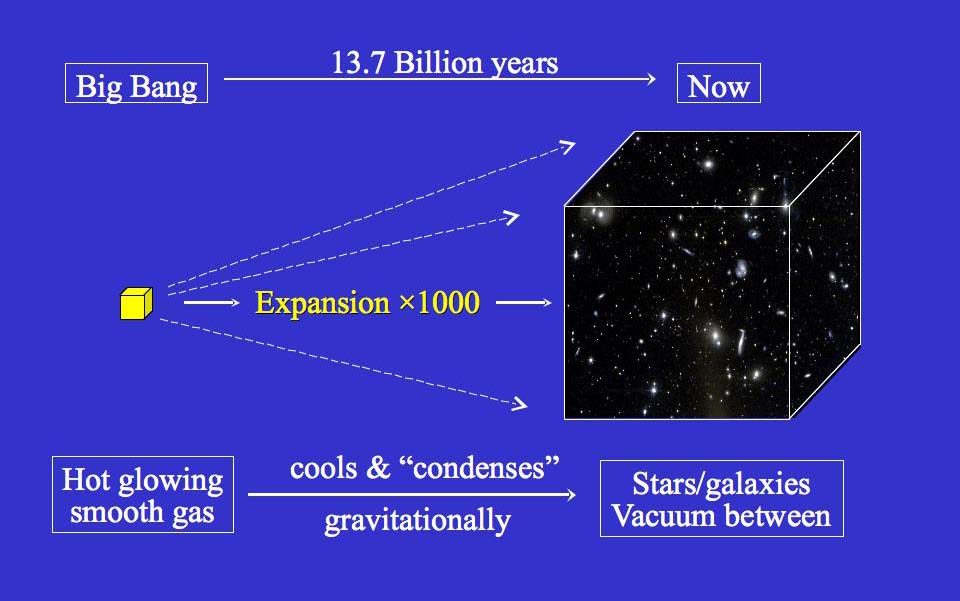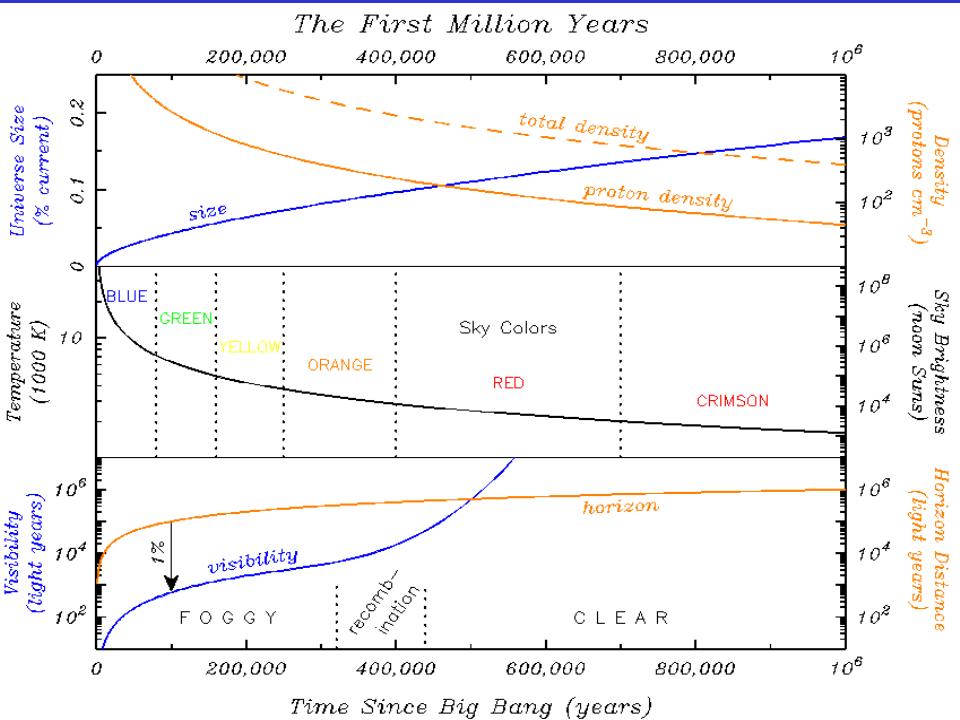
The first million years in the life of the Universe may sound like a long time to you or me, but it is equivalent to just the first day in the life of a human. As we will see, this period can be thought of as the acoustic era – sound waves form, grow and die before the close of that first day. So, let's spend a little time getting the feel of this ancient time.
Surprisingly, perhaps, we know quite accurately what it was like – thanks to the microwave background which gives us direct access to the midpoint of the era, allowing us to extrapolate backwards and forwards from that time. Three important facts make this extrapolation quite reliable. First, all the matter which we now find gathered into stars and galaxies was initially spread out extremely uniformly, as a smooth gas. Second, this gas was hot enough and dense enough to be in thermodynamic equilibrium – a very simple state in which all components interact and share a single well-defined temperature. Finally, as the Universe expands, the gas behaves just as you would expect for an expanding gas here on earth: it's density and temperature steadily decrease.
The next two images help illustrate the situation. The first sketches the overall change from a radically different youthful Universe filled with a hot smooth glowing gas, to the old cold lumpy Universe of today, filled with its stars and galaxies.
| click image for more explanation |

|
The second image shows the changing conditions across the first million years in more detail, when the Universe was roughly 1000 times smaller than it is today. As space expanded the gas became thinner and cooler: its density dropped from a few thousand to a few hundred protons per cubic centimeter – very thin by human standards – and its temperature dropped from a few thousand to a few hundred degrees – very hot by human standards. As it happens, despite its high temperature, the gas wouldn't burn you – it was way too thin.
| click image for more explanation |

|
What would have been lethal, however, was light's searing power. By far the most spectacular quality of those first millennia was the extraordinary brilliance and color of the whole sky. From every direction, the sky was aglow. Go to a time 100,000 years after the Big Bang when the cosmic temperature was similar to that of the Sun's surface, about 6000 °C. Now imagine a sky with not just one noon-day sun, but fully covered in suns – almost a million of them – everywhere shines with the Sun's brilliance. No shade in which to hide. It's like walking into a blast furnace set to the same temperature – the light alone would kill you instantly.
Allowing ourselves the luxury of surviving light's lethal brilliance, we would witness an extraordinary sequence of sky colors as the Universe aged and cooled. Roughly, with the passing of each 100,000 years, the sky color slowly moves through the rainbow sequence from purple, through blue, green, yellow, orange, red, to crimson, getting less bright all the while.
Amazingly, we can still witness that sequence – after 13.7 billion years the Universe has cooled to just 3 degrees above absolute zero, and the sky now glows feebly not in crimson, or even infra-red, but in microwaves. The microwave background is our present version of that ancestral sky. This is an extraordinary transformation, from a brilliance so powerful that essentially every process yields to its influence, to something so faint it is barely detectable. There is something almost sad about such a transformation — an inexorable decline from glorious leader to impotent bystander; a feeble shadow of its former splendor.
One of the reasons light plays such a dominant role for the first half-million years is that it is too hot for atoms to form, so their components – electrons, protons and helium nuclei – just zoom around freely. These wandering electrons scatter light quite efficiently and this scattering binds the light tightly to the gas — the gas is really an intimate fluid of light, electrons and nuclei, sharing their properties.
How would we experience this fluid of light and particles? As a bright fog — the scattering of light by electrons makes the gas foggy, one cannot see too far. Just how far you can see is shown in the bottom part of the previous graph. As the Universe expands and the gas thins, so the fog thins and one can see further. After 10,000 years you see 10 light years; after 100,000 years you see 800 light years. This is not quite a pea soup fog, but it does limit your view across the Universe.
Now, as it happens, in these early times you couldn't see too far anyway, regardless of the fog, simply because it takes time for light to arrive from distant parts. For example, after 1000 years the maximum possible visible distance (ignoring the fog) is 1000 light years – the distance light could have traveled since the Big Bang. This is called the horizon distance, since it acts like a terrestrial horizon, beyond which you cannot see (Topic 13 returns to horizons, which are important in the development of sound). Comparing these two distances, we find that for the first few hundred thousand years, fog limits your view to less than 1% of the distance to the horizon. During this time, light in the sky comes from the "nearby" glowing fog.
When the Universe cools so that electrons are captured to make atoms, the fog clears and one can see clear to the horizon. From then on the light in the sky comes from more ancient glowing gas, at the horizon – the situation we are now in.
Let's now take an itinerary of this hot cosmic atmosphere – what was it made of exactly? Here on Earth, our atmosphere contains 80% nitrogen and 20% oxygen. But these elements are late-comers in the cosmos, made inside stars several billion years after the Big Bang. The primordial atmosphere had none of them. Instead, the only atomic nuclei present were those of hydrogen and helium nuclei, in the ratio 12 to 1. [In a spectacular story, which predates our own, some hydrogen was converted into helium when the Universe was only a minute old and conditions everywhere were similar to those inside present day stars].
What about the relative amounts of light and atoms? Within Earth's atmosphere, under a noon sun, there are about a billion atoms for every photon of light. In the primordial atmosphere the situation was reversed: a billion photons for every atom — the gas was extremely bright but thin. Indeed, throughout the first million years the actual mass density of light exceeded the atomic mass density.
Finally, there was a sub-stratum of an unusual dark fluid – called "dark matter" – most likely made from an unknown kind of heavy particle. This dark matter was six times denser than atomic matter, and was the dominant source of gravity after 60,000 years. This sets the stage for all subsequent structure formation and is a primary, though silent, player. We will return to it several times in our story.